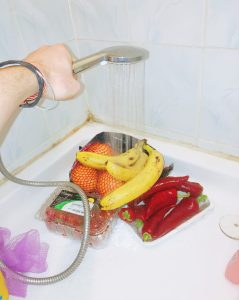One of the simplest and most effective ways to maintain a healthy diet is by incorporating more fruits and vegetables into your meals. However, before you start munching on your favorite produce, it’s essential to know how to wash fruit and veg properly. Washing fresh produce is crucial to ensure food safety and remove potential harmful germs and contaminants. This guide will provide you with the information you need to wash fruits and vegetables effectively and safely.
How to Wash Fruit and Veg: Step by Step

Preparing Fruits and Vegetables
Before washing fruits and vegetables, it’s essential to prepare them properly. Make sure to discard any damaged or bruised areas, as bacteria can thrive in these spots. If there are any visible dirt or debris, brush it away with your fingers or a clean produce brush; ensure the water you are using is cold, as warm water may affect the freshness of the produce.
Washing Method: Cold Running Water
The most common and recommended method for washing produce is by using cold running water. The USDA advises that you rinse produce under a steady stream of cold tap water for at least 30 seconds. This helps to reduce bacteria and remove any dirt, debris, or softened wax present on the surface of fresh fruits and vegetables.
Washing Method: Baking Soda and Lemon Juice
For more fragile produce, such as leafy greens or delicate berries, you may want to consider using a more gentle approach. A solution made with baking soda and lemon juice can help to clean produce without causing damage. To make this solution, combine one tablespoon of baking soda with a cup of cold water and a few drops of lemon juice. Soak the fruits and vegetables in this mixture for a few minutes, and then rinse them under cold running water to remove any remaining residue.
Commercial Produce Washes
If you prefer to use a commercial produce wash, ensure that it is a reputable product designed for cleaning fresh produce. Follow the manufacturer’s instructions carefully, and rinse the fruits and vegetables thoroughly after using the wash to remove any residue.
Organic Produce and Conventional Produce
Both organic and conventional produce can benefit from being properly washed before consumption. Organic produce may still contain traces of natural substances such as dirt or bacteria, while conventional produce may have residues from pesticides or other chemicals. Washing both types of produce helps to reduce the risk of foodborne illness and ensure food safety.
Drying Fruits and Vegetables
After washing fruits and vegetables, use a clean paper towel or a salad spinner to dry the produce thoroughly. Drying your fruits and vegetables helps to remove any remaining bacteria and prevents the growth of harmful germs.
Food Poisoning and Food Safety

Fruits and vegetables can be contaminated with harmful germs and bacteria that may cause food poisoning or other foodborne illnesses. These contaminants can come from various sources such as soil, water, raw meat, or cross-contamination during handling. Using proper washing techniques and following food safety guidelines can help to reduce the risk of foodborne illness.
Washing Delicate Produce
Delicate produce, like berries, tomatoes, and leafy greens, can be more susceptible to damage during washing. These types of fruits and vegetables should be handled gently and rinsed lightly with cold water to prevent bruising or crushing.
Washing Firm Produce
Firm produce, like apples, carrots, and potatoes, can tolerate more vigorous washing. Using a clean brush or your hands, scrub the surface of the fruits or vegetables while rinsing under a steady stream of cold water. This will help to remove dirt, debris, and any potentially harmful germs.
Washing Pre-Cut Fruits and Vegetables
Pre-cut fruits and vegetables should be washed before consumption, even if they are packaged and labeled as pre-washed. This is because bacteria can still be present on the surface of the produce, which increases the risk of foodborne illness. Simply rinse the pre-cut produce under cold running water and dry with a clean paper towel before consumption.
Tips to Ensure Vegetable Safety
To ensure the safety of your fruits and vegetables, it’s important to follow a few key steps:
– Always wash your hands before handling fresh produce
– Keep fruits and vegetables separate from raw meat, poultry, and seafood
– Wash produce even if you plan to peel or cook it, as bacteria can still be present on the surface
– Always use clean cutting boards, utensils, and containers when preparing fresh produce
By following these guidelines and understanding how to wash fruit and veg properly, you can minimize the risk of foodborne illness and enjoy healthy, delicious meals confidently.

